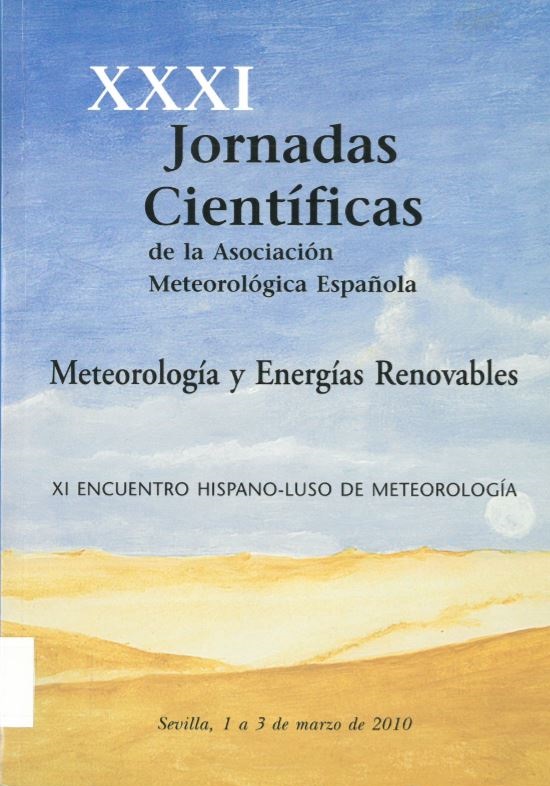CICLO DIURNO DEL CONTENIDO DE VAPOR DE AGUA
Resumen
El ciclo diurno del contenido de vapor de agua juega un importante papel en muchos procesos atmosféricos como las precipitaciones, la nubosidad, la estructura y evolución de los sistemas tormentosos, el balance de radiación, etc. Sin embargo, y a pesar de su importancia, su conocimiento es muy escaso debido a la ausencia de datos con la suficiente resolución temporal.La proliferación en los últimos años de redes de receptores de GPS, de los que se puede extraer el contenido total en columna de vapor de agua o agua precipitable (PW) (Bevis et al. 1992), va a permitir estudiar el ciclo diurno de este componente atmosférico al disponerse de datos con suficiente frecuencia temporal durante todo el día y en todas las condiciones meteorológicas.
Citas
Bastin S., Champollion C., Bock O., Drobinski P., Masson F. (2007): Diurnal Cycle of Water Vapor as Documented by a Dense GPS Network in a Coastal Area during ESCOMPTE IOP2. J. Appl. Meteor. Climatol., 46, 167–182.
Bevis M., Businger S., Herring T.A., Rocken C., Anthes R.A., Ware R.H., (1992): GPS Meteorology: Remote Sensing of Atmospheric Water Vapor using the Global Positioning System. J. Geophys. R. 97, 15787-15801.
Brunner F. K., M. Gu (1991): An improved model for the dual frequency ionospheric correction of GPS observations, Manusc. Geod., 16, 205-214, 1991.
Dai A., Deser C. (1999): Diurnal and semidiurnal variations in global surface wind and divergence fields. J. Geophys. Res., 104, 31,109– 31,125.
Dai A., Giorgi F., Trenberth K.E. (1999a): Observed and model-simulated precipitation diurnal cycle over the contiguous United States. J. Geophys. Res., 104, 6377–6402.
Dai A., Trenberth K.E., Karl T. R. (1999b): Effects of clouds, soil moisture, precipitation and water vapor on diurnal temperature range. J. Clim., 12, 2451–2473.
Dai A. (2001): Global precipitation and thunderstorm frequencies, II, Diurnal variations. J. Clim., 14, 1112–1128.
Dai A., Wang J., Ware R. H., Van Hove T. (2002): Diurnal variation in water vapor over North America and its implications for sampling errors in radiosonde humidity. J. Geophys. Res., 107(D10), 4090, doi:10.1029/2001JD000642.
Davis J.L., Herring T.A., Shapiro I.I., Rogers A.E., Elgered G. (1985): Geodesy by radio interferometry: Effects of atmospheric modelling errors on estimates of baseline length, Radio Sci., 20, 1593-1607.
Duan J., Bevis M., Fang P., Bock Y., Chiswell S., Businger S., Rocken C., Solheim F., van Hove T., Ware R., McClusky S., Herring T.A., King R.W. (1996): GPS Meteorology: Direct Estimation of the Absolute Value of Precipitable Water, J. Applied Meteorology 35, 830-838, 1996.
Elgered G., Davis J.L., Herring T.A., Shapiro I.I. (1991): Geodesy by radio interferometry: Water vapor radiometry for estimation of the wet delay, J. Geophys. Res., 96, 6541-6555, 1991.
Herring T., Davis J.L., Shapiro I.I. (1990): Geodesy by radio interferometry: The application of Kalman filtering to the análisis of very long baseline interferometry data, J. Geophys. Res., 95, 12,56112,581, 1990.
Jakobson E., Ohvril H., Elgered G. (2009): Diurnal variability of precipitable water in the Baltic region, impact on transmittance of the direct solar radiation, Boreal Env. Res. 14: 45–55.
Kimura F., Tanikawa R., Yoshizaki M. (1997): Diurnal variation of precipitable water in clear days over the northern mountains in Kanto plain (in Japanese). Tenki, 44, 799–807.
Li G., Kimura F., Sato T., Huang D. (2008): A composite analysis of diurnal cycle of GPS precipitable water vapor in central Japan during Calm Summer Days, Theor. Appl. Climatol., 92, 1529, doi:10.1007/s00704-006-0293-x.
Ohtani R. (2001): Detection of water vapor variations driven by thermally induced local circulations using the Japanese continuous GPS array. Geophys. Res. Lett., 28, 151–154.
Rocken C., Ware R., Van Hove T., Solheim F., Alber C. Johnson J. (1993): Sensing atmospheric water vapor with the global positioning system. Geophysical R. Letters, vol. 20, pag. 2631-2634, 1993.
Saastamoinen J. (1972): Atmospheric correction for the troposphere and stratosphere in radio ranging of satellites, in The Use of Artificial Satellites for Geodesy, Geophys. Monogr. Ser., vol. 15, edited by S. W. Henriksen, et al., pp. 247-251, AGU, Washington, D.C., 1972.
Sasaki T., and Kimura F. (2001): Diurnal variation of water vapor content over the Kanto area during
clear summer days observed through GPS precipitable water (in Japanese). Tenki, 48, 65–74.
Spilker, J. J. (1980): GPS signal structure and performance characteristics, in Global Positioning System, vol. 1, The Institute of Navigation, Washington, D.C., 1980.
Tralli D.M., Lichten S.M. (1990): Stochastic estimation of tropospheric path delays in global positioning system geodetic measurements, Bull. Geod., 64, 127-159, 1990.
Wang, J., L. Zhang, A. Dai, T. Van Hove, J. Van Baelen (2007): A near-global, 2-hourly data set of atmospheric precipitable water from ground-based GPS measurements, J. Geophys. Res., 112, D11107, doi:10.1029/2006JD007529.
Wu, P., J. Hamada, S. Mori, Y. I. Tauhid, M. D. Yamanaka, F. Kimura (2003): Diurnal variation of precipitable water over a mountainous area of Sumatra Island. J. Appl. Meteor., 42, 1107-1115.

